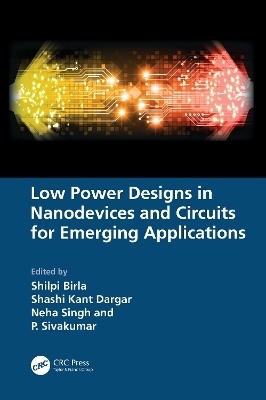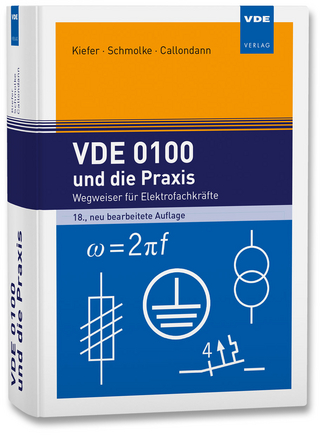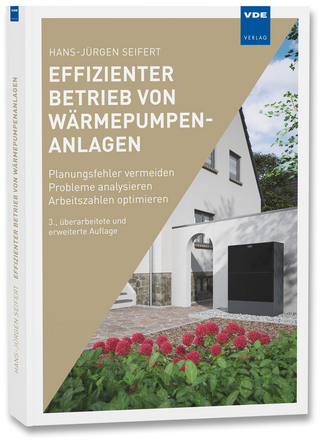
Low Power Designs in Nanodevices and Circuits for Emerging Applications
CRC Press (Verlag)
978-1-032-41277-1 (ISBN)
This reference textbook discusses low power designs for emerging applications. This book focuses on the research challenges associated with theory, design, and applications towards emerging Microelectronics and VLSI device design and developments, about low power consumptions. The advancements in large-scale integration technologies are principally responsible for the growth of the electronics industry.
This book is focused on senior undergraduates, graduate students, and professionals in the field of electrical and electronics engineering, nanotechnology. This book:
Discusses various low power techniques and applications for designing efficient circuits
Covers advance nanodevices such as FinFETs, TFETs, CNTFETs
Covers various emerging areas like Quantum-Dot Cellular Automata Circuits and FPGAs and sensors
Discusses applications like memory design for low power applications using nanodevices
The number of options for ICs in control applications, telecommunications, high-performance computing, and consumer electronics continues to grow with the emergence of VLSI designs. Nanodevices have revolutionized the electronics market and human life; it has impacted individual life to make it more convenient. They are ruling every sector such as electronics, energy, biomedicine, food, environment, and communication. This book discusses various emerging low power applications using CMOS and other emerging nanodevices.
Shilpi Birla is currently working as an Associate Professor at Manipal University, Jaipur. She has done B.Tech in Electronics & Communication Engineering, M.Tech in VLSI Design and Ph.D. in Low power VLSI Design from Uttarakhand Technical University, Dehradun India. She is having a total 14 years of experience, which includes teaching and industrial experience. She is a senior member of IEEE. She has authored and co-authored 80 research papers in journals of repute and international conferences. She is a reviewer and TPC member of several International Conferences. She is currently teaching, Microelectronics and VLSI Design courses at UG & PG level. She is also a reviewer of several journals like Microelectronics Journal, International Journal of Electronics, and many more IEEE-sponsored conferences. Two Doctoral degrees have been awarded under her guidance. She is guiding four Ph.D. students in Low Power VLSI & Nano devices. She has set up VLSI Lab in different institutes. She has conducted short-term courses in TCAD, HSPICE and Fabrication and workshops at National Level in VLSI Domain. Her research area is VLSI Design, Digital System design, Analog VLSI & Image Processing. Dr. Shashi Kant Dargar is currently working as an Associate Professor in the Electronics & Communication Engineering Department at Kalasalingam Academy of Research and Education, Tamilnadu, India. He received his Ph.D. degree (2017) in microelectronics, Master's (2013) in digital communication, and Bachelor's (2005) in electronics and communication engineering. He completed his three-year post-doctoral research in electronic engineering at the University of KwaZulu-Natal, Durban, South Africa. He has contributed to research and academics for 16 years, including microelectronics, thin-film device design, VLSI, wireless communication, and microwave & communication engineering. He taught Analog Integrated circuits, VLSI signal processing, VLSI Technology, Analog Devices, Circuits, Signals and Systems, Digital Signal Processing, Communications and Low Power VLSI design. At the postgraduate level, Thin Film Electronics, Flexible Electronics, Sensor devices, Microwave and Communication, Semiconductor Device Modelling and Quantum electronics. He has authored 41 scientific research articles in reputed journals and conferences. He is a Senior Member of IEEE and Life Member of IEEE HKN- Mu Eta Chapter. Dr Neha Singh is a well-rounded and dynamic teaching professional with 19 years of in-depth experience in educating undergraduate and postgraduate engineering students in Electronics & Communication Engineering. She is currently working as Assistant Professor, in the Department of Electronics & Communication Engineering at Manipal University Jaipur, Rajasthan, India. She did her PhD in the year 2020. Her areas of research interest include Image Processing, Machine learning, VLSI design and nanodevices. She has several papers and book chapters published in Journals and conferences of repute. She has co-authored engineering textbooks and edited a book on Nanotechnology: Device Design and Applications. She has served as reviewer in various International and peer reviewed Journals and conferences. She has also worked as Convener, Session Chair and organizer of various international conferences, summer internships in Diode Fabrication and Faculty Development Programs. She has guided several M Tech Dissertations and B Tech projects and guiding PhD scholars as well. Dr P Sivakumar is presently working as a Professor & Dean School of Electronics, Electrical and Biomedical Technology at the Kalasalingam Academy of Research and Education in India. He received his Undergraduate degree from Madurai Kamaraj University, India, in 2001, and his PhD degree in VLSI design from Anna University, Chennai, India, in 2013. He has published 80 papers in peer and refereed Journals and chapters in books. He participated in his research in the various forums of VLSI Design. He is currently teaching RTL logic and system design course. He also presented various academic and research-based papers related to VLSI, Image processing and Optimization at several national and international conferences. He has teaching experience of almost 20 years of in Electronics and Communication. He is in the reviewer panel of many Journals for reviewing scientific manuscripts. And he has supervised more than 30 PG and PhD Scholars. He has also been involved as an investigator and co-investigator in several Projects & Consultancy supported by Government agencies in India.
Chapter 1
Low Power VLSI Design Using Clock Gated Technique
J.L Mazher Iqbal, A. Selwin Mich Priyadharson, T. Manikandan, V.S. Janani, A. Jose Anand
Chapter 2
Emerging Applications and Challenges in Low Power Device Designs in Flexible and Stretchable Low Power Devices and Strategies
Anurag Nain, Divya Bajpai Tripathy, Anjali Gupta, Vinny Sharma
Chapter 3
A Highly Stable Reliable Ultralow-Power Design for 11T Near-Threshold FINFET SRAM
Erfan Abbasian, Maryam Nayeri
Chapter 4
Investigation and Optimization of High Stability 6T CNTFET SRAM Cell with Low Power
M. Elangovan, S.Jayanthi, P.Raja
Chapter 5
Study of Transistor Sizing Techniques for Low Power Design in FinFET Technology
Ehsan Mahmoodi, Morteza Gholipour
Chapter 6
Emerging Nano Devices for Low Power Applications: A Research Point of View
G.Boopathi Raja
Chapter 7
A Review of the Current Research on Graphene and its Promising Future
Sujit Kumar, H.K. Yashaswini, V. Trupti, Hannah Jessie Rani, Raghu N
Chapter 8
Analysis and Optimization for Low Power SRAM Cells
Deepika Sharma, Shilpi Birla
Chapter 9
A Comparative Review on Leakage Power Minimization Techniques in SRAM
Appikatla Phani Kumar, Rohit Lorenzo
Chapter 10
Nonvolatile Configurable Logic Block for FPGAs
Chee Hock Leong, T. Nandha Kumar, Haider A.F. Almurib
Chapter 11
Efficient Layout Techniques to Design Physically Realizable Quantum-Dot Cellular Automata Circuits
Marshal R, Raja Sekar K, Lakshminarayanan Gopalakrishnan, Seok-Bum Ko, Anantharaj Thalaimalai Vanaraj
Chapter 12
Low Power Reduction Techniques for A 6T-SRAM Cell Design using CNTFET Technology
G. Karthy, P. Sivakumar, T. Jayasankar
Chapter 13
Design and Development of Integrated Low power High Performance MOSFET Structure
Debasis Mukherjee
Chapter 14
Low Power Designs for Enhanced CMOS Performance
Gowsika Dharmaraj, Ashwin Kumar S, Chandra Prakash S, Reba P
Chapter 15
Recent Advances in Carbon Nanotubes Based Sensors
Amandeep Kaur, Jitender Kumar, Avtar Singh
Chapter 16
Low Power and Low Area Multiplier and Accumulator Block for Efficient Implementation of FIR Filter
J. L Mazher Iqbal, G. Narayan, T. Manikandan, M. Meena, Jose Anand
Chapter 17
One-Sided Schmitt-Trigger-Based 10T SRAM Cell with Expanded Read/Write Stabilities and Less Leakage Power Dissipation in 10-nm GNRFET Technology
Erfan Abbasian, Mahdieh Nayeri, Shilpi Birla
Chapter 18
Advances in Low Power Devices: FinFETs, Nanowire FETS, and CNT FET
Savitesh Madhulika Sharma, Avtar Singh
| Erscheinungsdatum | 16.11.2023 |
|---|---|
| Zusatzinfo | 42 Tables, black and white; 210 Line drawings, black and white; 13 Halftones, black and white; 223 Illustrations, black and white |
| Verlagsort | London |
| Sprache | englisch |
| Maße | 156 x 234 mm |
| Gewicht | 790 g |
| Themenwelt | Technik ► Elektrotechnik / Energietechnik |
| Technik ► Nachrichtentechnik | |
| Technik ► Umwelttechnik / Biotechnologie | |
| ISBN-10 | 1-032-41277-1 / 1032412771 |
| ISBN-13 | 978-1-032-41277-1 / 9781032412771 |
| Zustand | Neuware |
| Informationen gemäß Produktsicherheitsverordnung (GPSR) | |
| Haben Sie eine Frage zum Produkt? |
aus dem Bereich


